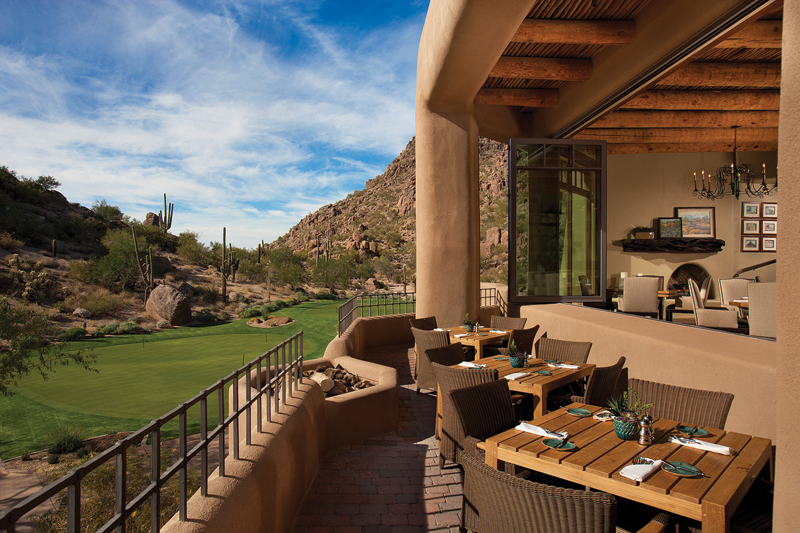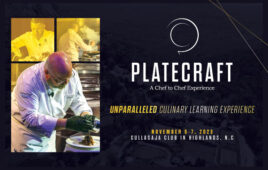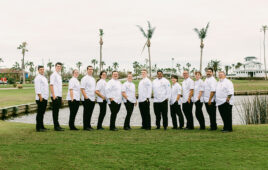Through the dramatic swing in the Arizona seasons, Executive Chef Daniel Chagolla provides a steady diet of popular dishes and events for diners at Desert Highlands GC.
Desert Highlands Golf Club lies in the serenity of the Sonoran Desert near Scottsdale, Ariz. A model for land preservation, the mantra of the entire development team when creating the property in 1980 was “Above all, protect the site.”
The clubhouse at Desert Highlands defines the relaxed ambiance of simply being welcomed. Helping to enhance that atmosphere for the past seven years has been Daniel Chagolla, first as Executive Sous Chef and then for the past four years as the club’s Executive Chef. We appreciate Chef Chagolla taking time to share what life is like for him in this region of natural beauty.
Q: Chef, you spent three years as Executive Sous Chef at Desert Highlands prior to moving up to the Executive Chef position. Tell us the advantages you had by making this progression, and how it helped you face the challenges you encountered after your promotion.
| Daniel Chagolla CHEF PROFILE Current Position: Executive Chef, Desert Highlands Golf Club, Scottsdale, Ariz. (2010-Present)
Education and Professional Affiliations:
|
A: I started as Executive Sous Chef in September 2007 after working in resorts for the previous 16 years. Becoming Desert Highlands’ Executive Sous Chef was a nice change. I worked hands-on in the kitchen, overseeing banquets and being able to apply my own personal touches. I got to know the membership’s likes and dislikes with food, which helped me tremendously. We are “a family serving family.”
I stepped into the Executive Chef position in October 2010, just coming out of the slower summer season and going into our busy season. The challenges included staffing, training, plus the annual welcome-back party, as well as Thanksgiving and Christmas to follow.
Q: You explained to me that your menus in the peak season are very different than in the off-season. Why is this, and what drives the process?
A: During the “peak season,” the foods are rich with creams, butter, game, and braised meats, to highlight seasonal products. At this time we also have several smaller, lighter but flavorful dishes to offer to our membership, along with a few comfort items that are traditions here at Desert Highlands.
As the temperature rises here in the desert and a la carte business slows down, we condense the menu and offer a lighter, refreshing menu. Fresh fruit and vegetable relishes replace creams and butter sauces.
Q: Tell us about “Chefs Gone Wild” at Desert Highlands—it sounds like an extremely popular program. How do you market it and menu-plan it?
A: “Chefs Gone Wild” started in September 2008. We marketed through the member website, word of mouth and newsletters. The first few started out slow, but shortly after it became one of the most popular events with the membership.
Six chefs are responsible for the creation, prepping, presentation and serving of their individual dish by using seasonal products. They are responsible for knowledge of their dish and presenting it to the membership at stations in the multiple dining areas. At the end of the dinner, the members vote for their favorite dish. The most popular dish is then featured in the following menu change.
Q: Your “Burger of the Month” feature is popular as well. How did this start, and what are the most successful toppings?
A: Our clubhouse renovation in the summer of 2013 allowed us to revise our menu format and add new menu items. We started with a competition among the culinary staff to determine who could create the best burger and help us establish a signature “DH Burger.” The winner would have their burger on the menu.

For Arizona’s dramatic swing in seasons, the Desert Highlands culinary staff adopts different menu approaches to provide dishes that fit the temperatures and time of year.
I excluded myself from the competition; the General Manager and two Board members would choose the winner.
When the tasting was over, the judges commented that all the burgers were wonderful and they could not decide on just one. This led to the invention of the “Burger of the Month”; one of these burgers would be showcased on the monthly menu change throughout the year.
Popular toppings for the burgers have included Saint- Andre cheese, whiskey portabella mushroom, jalapeno bacon, tempura avocado, grilled pineapple, smoked cheddar, smoked shallots, and black mission fig aioli.
Q: Daniel, talk about your takeout business—how does it work from a logistical standpoint and how, if at all, does it affect the rest of the operation?
A: The orders are taken by the receptionist and a la carte line cooks assemble the order. Five minutes before pickup, the order is done. That gives the front line expediter time for bread service, to assemble condiments, ensure the order is correct, and then deliver the order to the member at the clubhouse valet station.

Desert Highlands’ recent clubhouse renovation led to a spike in a la carte dining, even though the club has a well-established and popular takeout program.
Multiple orders are placed at five-minute intervals. For 99.9% of the time, it does not affect a la carte service, but there have been times at night when to-go orders and a la carte orders must be ready for pickup at the same time. We focus on staying on time with our to-go orders by communicating to the receptionist on varied pickup times.
Current year-to-date to-go orders are running at 22% of total covers. This is 14% less than last year because we’ve seen an a la carte spike, due to the membership enjoying the renovation to the clubhouse.
It should be noted that we are incorporated as a Homeowners Association in Arizona and not as a 501 c (7) country club, which gives us more flexibility for to-go service.
Q: Daniel, you expressed that you are far enough out of Scottsdale that public transportation doesn’t exist. What have you done to solve your staffing challenges at Desert Highlands?
A: I have reached out to culinary schools in the Scottsdale area and placed ads in local newspapers. We have also used social media and at times utilized temporary labor to fill in.






